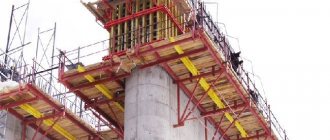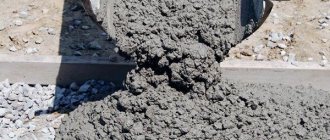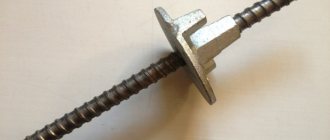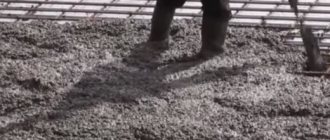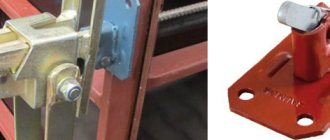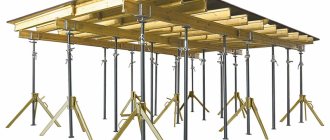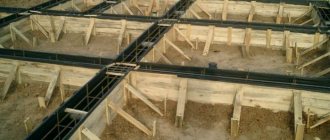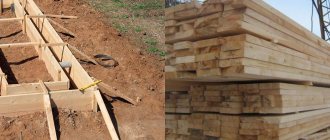The devices that appeared during the development of monolithic construction technology simplified and reduced the cost of previously labor-intensive and costly construction processes. A simple invention - a formwork stand - allows you to install monolithic floors of various configurations (straight, inclined, with capitals) for any buildings with floors up to 400 mm thick and up to 4.5 m high: from a private house built with your own hands to an industrial premises.
Formwork on telescopic stands
A telescopic stand is an easy-to-use and reliable device that serves as a support for floor formwork. Thanks to their low weight (no more than 20 kg), installation of telescopic supports can be easily done even by one person.
Formwork elements and tools
- telescopic stand,
- support tripod,
- unifork with corner, pin or groove,
- wooden beams,
- formwork base (plywood, polystyrene boards, etc.),
- support corners for forming edges,
- level.
One telescopic stand - the jack can withstand up to 2 tons of load.
They are produced in various modifications. In the production of telescopic stands, the purpose of the device is taken into account. For a one-time construction of a one-story house, it is possible to rent the smallest rack with the extension of the rod to a level of up to 3.1 meters. Floor formwork elements
The largest telescopic post can hold the formwork at a height of 4.5 meters. Pipe diameter is 60 mm, wall thickness is 2.3-2.8 mm. The jack is equipped with forged nuts at the top and bottom, which allow it to maintain the tightness of the structure and prevent the pipe from “opening.”
The design of the tripod holding the stand is universal. Thanks to its low height of 60 cm and the angle of rotation of the legs up to 180 degrees, you don’t have to take corners and walls into account when installing it.
Unifork is a device for holding load-bearing beams, which is attached to the upper forged beam. There are three types of uniforks:
- a device with four pins for holding the beam,
- a corner to which a beam can be screwed for greater strength,
- device with a groove for timber. The latter device is usually used in conjunction with other types of uniforks.
Installation of the structure
Before you begin installing the formwork, you need to calculate the thickness of the floor. Depending on the span length, the thickness of the floor can range from 120 to 240 mm. If the span is longer than 7.5 meters, additional load-bearing beams or support columns must be added.
Removable formwork for pouring floors
The thickness of the floor is calculated using the formula: span length in millimeters divided by 30.
Let's consider the order of installation work:
- On the site under the ceiling, the installation points of the racks are marked. The distance between them should be 0.6-1 meter. If the site is not stable, a wooden base is laid on it.
- Each jack is connected to a tripod.
- The racks are placed according to the previously applied markings.
- Uniforks are installed in the upper forged nuts.
- Load-bearing beams are attached to the uniforks.
- I-beams are laid perpendicularly on the supporting beams with a pitch of 40-50 cm.
- Set reference angles.
- Lay laminated plywood, which will hold the concrete until it hardens completely.
- The horizontalness of the plywood is checked using a level. If the surface is uneven, adjust the stands.
The formwork is ready. You can lay reinforcement and pour concrete.
Installation of a volumetric structure
The volumetric design allows you to fill the ceiling at a height of up to 20 meters, but this does not mean that the principle of its installation is very different from a simple design.
The beginning of work is to prepare the site. Lower jacks are installed on it, which will regulate the horizontality of the structure. The stability of the scaffolding will depend on the correct installation level.
Installation of volumetric formwork structure for floors
The lower rails and racks are attached to the jacks. Next, everything is assembled according to the principle of a designer, taking into account the level.
At the end, upper jacks and uniforks are installed, to which the beams are attached. Then everything is done the same as in the first case.
Scaffolding and other equipment for volumetric formwork are very expensive. Therefore, the best option would be to rent from a construction company.
Overview of telescopic supports for floor formwork
Stand for formwork: purpose, device. Types, method of using formwork racks.
What does the telescopic stand consist of?
The jack stand is actually two pipes:
- external (guide) (Fig. 1)
- internal (telescopic insert) (Fig. 2).
The rack is limited from below and above by flat square flanges that serve as stands. They have holes in the corners that allow you to anchor the stand.
The stand works within a certain height range. The height change from minimum to maximum occurs due to the extension of the inner tube - holes are provided in it for rough adjustment.
To fix the inner pipe at the required height, the outer pipe is equipped with special elements:
- tensioner - a nozzle with a thread and a groove, located at the end of the outer pipe;
- earring – a special removable clip-type retainer that serves as a stopper for the upper insert;
- nut – an additional removable stop that supports the shackle and provides more accurate height adjustment by moving along the tensioner thread.
Assembling the telescopic stand step by step (Fig. 3-4). Assembling the floor formwork stand is quite simple. A nut is screwed onto the outer guide onto the tensioner, and an earring is placed on top.
After this, the inner one is inserted into the outer pipe, and the axis of the holes in the telescopic insert must coincide with the hole in the tensioner. The insert is lowered to the required height and fixed with an earring.
When renting, a telescopic stand is usually equipped with a tripod and a unifork . The tripod is used as a stand: it fixes the stand in a vertical position, significantly increasing its stability. The unifork is inserted on top of the rack and is used to further secure the beam.
Types of floor formwork (monolithic and beam-transom)
Floor formwork is classified based on the method of its application, type of construction, and material of manufacture. According to the methods of its use, a distinction is made between removable and non-removable structures. Separately, we can distinguish a subtype of removable formwork - sliding formwork.
In the latter case, installation occurs using materials that then become part of the ceiling, for example, corrugated sheets or polystyrene foam are used for this purpose. Removable formwork can be transferred or rented - for the required number of days. The material can be used: ordinary plank structures, aluminum and steel, and plywood formwork.
Depending on the type of construction, you can make the following formwork with your own hands:
- monolithic;
- beam-transom;
- caisson formwork;
- frame or vertical panel formwork;
Do-it-yourself installation of formwork for monolithic slabs is done using telescopic racks. With its help, inclined surfaces are formed. Its structure includes the following elements: deck (I-beams with laminated plywood) and supporting parts (telescopic racks).
During monolithic construction, the device can be disassembled—removing the side panels—3 days after pouring. How long it takes to remove the support beams depends on how long it takes for the concrete to reach the characteristics specified in the project.
Application of formwork for floors
Beam-transom technology involves installing a frame of beams and crossbars with further laying of panels on them. Such a device has an undeniable advantage - it is possible to form structures of any length without restrictions.
The panels are mounted on the floor, and then pulled together through the crossbars using studs (double-deck design) or supported on supports (single-deck design).
Caisson and frame construction for floors
Do-it-yourself installation of coffered formwork involves installing them on panels before pouring volumetric elements, for example, laminated plywood. The shields form a coffered frame. The formwork includes elements such as a deck, posts, which can be rented.
Before pouring the formwork with concrete, longitudinal forms are installed on the main panels. After hardening, they form a ribbed surface. How long before stripping can take place? If we are talking about the Skydome system, then the formwork can be removed after 4-5 days, leaving the support beams for the formwork to completely harden for another 28 days.
Panel or frame formwork for floors includes the following elements: panels and supports. A corrugated sheet or a welded frame made of aluminum or steel is used as a shield. A deck made of 18 mm laminated plywood with moisture-resistant properties is fixed on it, which can be rented. The structural elements are connected by two types of locks.
Application of formwork for floors on a construction site
Short locks are used to grab the panels together, long locks are used to make the surface even. How long after the formwork can be removed depends on the rate of hardening of the concrete. It is worth leaving supports with a span of at least 3 meters. When the concrete reaches its design properties, you can begin dismantling the supports from the middle to the edges of the floor.
Permanent formwork for floors
To install permanent formwork, a load-bearing profiled sheet is used. It is marked “H” and is made from steel sheet 0.65 mm thick. Additional stiffening ribs allowed it to have optimal load-bearing capacity.
The height of its ribs is in the range of 50-150 mm, and the length is from 1 to 12 m. The material is effective if you need quick installation of the ceiling. Reinforcement is laid on it and concrete is poured. The absence of the need to remove the corrugated sheet with your own hands reduces labor costs and cash costs for repairing the ceiling and purchasing laminated plywood.
The professional sheet has the following advantages:
- long service life without loss of presentation;
- light weight, no pressure on the foundation, unlike caisson or beam structures;
- easy installation that you can do yourself;
- The corrugated sheet is resistant to corrosion;
- resistance to snow loads;
- a comparative calculation shows its cheapness.
Cost of products
Stands for formwork structures vary in cost depending on the type of product and its length. For example, for a service station the prices will be as follows.
| Maximum height, m | Cost of painted model, rub. | Cost with galvanized thread, rub | Cost of fully galvanized, rub |
| 3,1 | 620 | 657 | 777 |
| 3,7 | 667 | 704 | 846 |
| 4,2 | 756 | 793 | 1019 |
| 4,5 | 819 | 837 | 1500 |
If we are talking about STZ, then the telescopic stand will cost a little more.
| Maximum height, m | Cost of painted model, rub. | Cost with galvanized thread, rub | Cost of fully galvanized, rub |
| 3,1 | 667 | 759 | 1000 |
| 3,7 | 701 | 793 | 1100 |
| 4,2 | 862 | 954 | 1300 |
| 4,5 | 1000 | 1090 | 1540 |
Reinforced models are considered the most expensive, their cost ranges from 730 to 3200 rubles.
It is also worth considering the manufacturer when purchasing products. The cheapest stands are considered to be products from Doka (650-1300 rubles). Designs from the manufacturer PERI will cost a little more.
However, in addition to the racks themselves, you will additionally have to purchase a tripod for 250-300 rubles per piece and a unifork (about 70-100 rubles).
It is much more profitable to rent the necessary products. In this case, a support up to 3.1 m long will cost only 5 rubles per day, and a tripod will cost 3 rubles. If you take structures for a longer period (for example, a month), you can save even more (a month of using the stand will cost only 100 rubles).
Useful tips
When work is underway to form floor formwork, you can, again, use removable and non-removable options. Choosing a specific type is largely a matter of personal taste. Recommendations:
- laying polyethylene film will protect against leaks of the concrete mixture;
- when using wood for formwork, it is useful to additionally tighten the boards located on top with reinforcing wire;
- It is advisable to pour concrete in layers;
- when pouring the entire mass at the same time, you must ensure that the solution does not overflow;
- exclude excessively active processing of the solution with vibration devices (if possible, replace it with manual bayonet);
- disassemble the formwork from top to bottom (which eliminates the appearance of chips and cracked areas).
It is worth remembering about the key mistakes that can be made when forming the formwork. We are talking about:
- use of low-quality wood, poor metal;
- using an inch board (it is difficult to strengthen);
- insufficient depth of vertical cross beams;
- excessively large or too small distance between the shield and the trench wall;
- leveling the surface by adding soil (it must be removed and removed, not added!);
- unevenness of the installed parts vertically and horizontally;
- lack of sealing of wooden joints using tow.
In the next video you will find a step-by-step installation of wooden formwork with loose trench slopes and a large difference in heights on the building site.
What is needed for the work?
Among the components for formwork, the unifork plays a special role. It is even included in the official sets of factory universal formwork. The main task of uniforks is mechanical maintenance. They are used to work on both vertical and overlapping slabs. These elements turn out to be the final part of the prefabricated kit.
A special two-level strut is designed to guarantee the spatial stability of the structure. In some cases, due to the braced elements, the shields are adjusted (set exactly according to the design values). There is a difference between single-level and two-level products. The support of the formwork is also the crossbar. It must be emphasized that, along with formwork, there are also frame crossbars, and they should absolutely not be confused.
The crossbar solution guarantees:
- installation at any convenient point;
- load-bearing characteristic at the level of 8000 kg per 1 m2;
- minimal time investment.
And also for normal formwork you definitely need nuts and clips. Another name for clips is a spring clip, which comprehensively explains their function, internal structure, and operating principle. They are needed for steel, plastic and laminated plywood panels
But there are no trifles in construction, and therefore it is necessary to pay attention even to PVC pipes. Its task is to prevent the concrete solution from getting on those parts that may be damaged by it; therefore, the screeding of the panels can be done without problems
Beams allow you to increase the stability of the fastening. These are I-beams made of wood. They are used when casting ceilings and other structures. Such products are easy to install. The spacers deserve a separate discussion. They are also sometimes called braces.
The distance between the stop points, which prevents the formwork from creeping under the load of the overlying structures, should be a maximum of 1 m. Double-sided installation of stop units is needed in the corners where the load is greatest. A cone is another type of protective component that covers the free ends of tubing. And when arranging floors, a telescopic stand is often needed. They have open or closed cuts. The rack includes a pair of pipes made of steel or aluminum. The closed type of cutting means covering it with an outer cylinder (casing). The length of the racks is a minimum of 1.7 m, a maximum of 4.5 m.
Types of formwork and their elements
Below is a list of the most common types of formwork systems in modern construction and the elements from which they consist.
Small panel or standardized formwork is used in the construction of monolithic objects of various dimensional categories. Its structural elements are:
- shields of various sizes (from 0.9/0.3 to 1.8/0.6 m) and weighing up to 50 kg;
- prefabricated elements (spacers, racks, etc.);
- fastening elements – locks (wedge, eccentric, spring), clamps, trusses, etc.;
- telescopic crossbars, racks, struts, ladders, etc.
Elements of small panel formwork
Large-panel formwork, which belongs to the prefabricated category and is used in civil and industrial construction, is intended for the construction of large-sized monolithic structures. The functional elements of this type of system are:
- panels used as an independent structural element or assembled into a complex if necessary and combined using fastening systems. The length of the shield is from 2.1 to 5.7 m; there are ordinary and end shields;
- struts with a jack, necessary for vertical alignment of the panels;
- tie bolts (Fig. 5) fastening the formwork panels to each other. In order to make the connection of the shields more precise, wedge locks are used (Fig. 6);
- frames and racks used when pouring massive structures and thick-walled structures of long length;
- contractions and rigid connections used when working with structures whose thickness exceeds 300 mm;
- scaffolding is a platform for placing the pourer and his working accessories.
Large-panel formwork: a - frame, b - frame-panel for massive walls; 1 - brace brace, 2 - deck, 3 - shield frame, 4 - clamp, 5 - screed, 6 - cantilever scaffolding, 7 - strut, 8 - mechanical jack, 9 - stiffening connection, 10 - screed, 11 - spacer, 12 — lighthouse board
Climbing formwork is a type of formwork used when pouring tall objects such as cooling towers, pipes, various towers, etc. This complex, multi-level system consists of:
- a complex of external panels 1.25 * 0.55 m, suspended on supporting rings;
- stiffening ribs mounted at the joints of the shields;
- metal sheets acting as an internal shield, connected with brackets and reinforced with steel strips.
Climbing formwork: 1 - concreted wall; 2 - external formwork panels; 3 - internal formwork panels; 4 - lifting device; 5 — shaft of the support-lifting device; 6 — pendants; 7 - working platform; 8 — support beams; 9, 10 - external and internal suspended scaffolding
Block formwork (block form) is a type of formwork that is used when pouring grillages, elevator shafts, stepped foundations and other things. There are detachable and one-piece block forms. The one-piece version consists of a pillar shape and a step, equipped with mounting loops for the operation of jacks during formwork removal. The detachable type of this system includes:
- step shields;
- fastening elements;
- the shape of the column;
- thrust brackets for jacking;
- squeezing device.
Block formwork of the internal contour is detachable: 1 - external contour panel, 2 - internal circuit panel, 3 - internal corner panel, 4 - lock, 5 - grip, 6 - insert
Block-panel vertical formwork has several modifications that have become widespread when pouring vertical objects located indoors. Depending on the technological features, the elements of the complex may change, but there are universal components present in each of the existing variations of this system. These include:
- lower frame equipped with outriggers and guides interacting with the core;
- spatial core, represented by vertical posts, consoles, brackets and gussets. There are also special technological holes in which shields are attached;
- large-panel panels equipped with a fastening element for hanging on core elements and side posts using brackets. For this type of formwork, two types of panels are used - internal (up to 2.5 m high) and external (up to 2.9 m high). The maximum load adequately absorbed by this system is 50 kN.
1 - common frame, 2 - rigid spatial core, 3 - large-panel panels, corner vertical panels, 4 - corner vertical elements, 5 - outriggers, 6 - consoles, 7 - vertical connecting elements
31.10.2016
Main characteristics and types of beams for formwork
Currently, several types of beams are relevant. Among the most popular is the domestically produced beam – BDK-1. This element is made of timber, painted and treated with protective mixtures. In the standard version, the beam has the following parameters:
- length from 1.5 to 4.5 m;
- width - 8 cm;
- height – 20 cm.
Each beam has a shelf 4 cm thick and a shoulder width of up to 2.7 cm. Thanks to the design features and the material used, the finished beam structure can withstand a load exceeding 400 kN.
Beam for floor formwork BDK-1
The BDK-1 beam is made from LVL timber and coniferous wood, glued and treated with synthetic compounds that block the action of environmental factors and parasitic activity. The classic model of this type can be recognized by its characteristic yellow color and corresponding markings. According to GOST, the BDK-1 beam must have a high density (not lower than 450 kg/m3), the moisture content should not exceed 13%, and the weight should vary around 6 kg/linear m. In order for the finished system to meet all requirements, when assembling it, a maximum interval between beams should be maintained, which should not exceed 1.5 meters.
An equivalent analogue of the domestic BDK-1 is the N-20 beam, made of coniferous timber and having a plywood (FSF) core. The dimensions of the beam for formwork of this modification range from 1.8 to 4.5 meters; the formwork assembled on its basis can withstand loads of up to 500 N/linear m. A high-quality beam of this modification must meet the requirements of GOST 20850-84.
GOST 20850-84 Glued wooden structures
Beams are also distinguished by the material from which they are made; in addition to wooden – classic beams – there are beams made of aluminum and plastic. It is also possible to divide them according to operational characteristics. In this case, we can note leveling, load-bearing, forming, auxiliary beams, etc. Each variety has its own parameters, depending on size, design and material.
Specifications
For the convenience of choosing racks for floor formwork, their main characteristics are given in the tables:
| Overlapping dimensions by thickness and height | 3m/30 cm | 3 – 4.5 m/30 – 40 cm |
| Rack type | Standard | Reinforced |
| Length, m | 3.1 – 4.2 | Up to 4.5 |
| Support diameter, cm | 6 | 7,6 |
| Pipe wall thickness, mm | 2 | 3 |
| Diameter size of telescopic type insert, cm | 4.8 – 5.1 | 6 |
| Insert wall thickness, mm | 2.5 | 3 |
| Rack installation pitch, m | 1.5 | 1 |
Dimensions of racks and their weight:
| Name of the telescopic stand | Height, m | Dimensions of diameter and thickness, mm | Weight. kg | |
| Interior | Outer | |||
| SD 2.1 | 1.2 – 2.1 | 60/2 | 51/2.5 | 9.44 |
| SD 2.5 | 1.4 – 2.5 | 10,6 | ||
| SD 3.1 | 1.7 – 3.1 | 11.87 | ||
| SD 3.7 | 2.0 – 3.7 | 13.74 | ||
| SD 4.2 | 2.5 – 4.2 | 15.17 | ||
| SD. 4.5 | 3.0 – 4.5 | 16.16 | ||
Floor formwork - types and features
Floor formwork is one of the main elements used in monolithic construction. Today, there are many varieties of such systems that allow the installation of structures at various heights in compliance with all technological requirements and ensuring safe working conditions.
Floor formwork elements
Structurally, the entire set of equipment consists of a number of elements that perform certain functions:
- deck,
- load-bearing formwork structure,
- support posts.
The deck forms the lower surface of the floor, and the concrete mixture is poured directly onto it.
Can be made from various materials:
- metal,
- plywood or OSB (most often moisture-resistant and laminated),
- various types of artificial materials - plastic, polystyrene foam.
It is also equipped with additional elements that form the side surface of the ceiling in thickness.
Supporting structure of the formwork. Its main element is the floor formwork beam; the deck is laid directly on it. Designed to distribute the load created by the concrete layer. Wooden or metal profiled elements are usually used for this purpose; this design provides better load-bearing capacity.
During installation, it is necessary to strictly observe the installation step of the beams; systems with two rows of such elements, longitudinal and transverse, are used.
Floor frame formwork is also used as a load-bearing support; it consists of elements that are mounted in the form of a solid structure that provides high performance characteristics. Installation of such a structure is carried out over a slightly longer period of time.
Support posts for floor formwork ensure the functionality of the entire structure. They transfer the load created when pouring concrete and forming the floor to the underlying working structures and support the entire system.
Racks, depending on the principle of operation, are:
Their design allows you to change the height, which allows you to install floors at different levels. The racks also include support tripods and support heads intended for fixing load-bearing structural elements in them.
If there is a significant difference in height between the floors, so-called volumetric floor formwork should be used. Its design is different in that all the racks included in the kit and bearing the load are connected into one system using special crossbars.
This prefabricated structure allows:
- achieve increased stability of the formwork,
- significantly improves load redistribution.
Floor formwork on telescopic racks is becoming increasingly popular. This design greatly simplifies the process of adjusting the system (setting a certain level).
Recommendations
We have listed all the parameters of supporting structures. Now, when choosing building materials and the type of formwork, you can take into account in advance the dimensions of the telescopic racks, based on the project-planned dimensions of the floors of the facility being built, and calculate the upcoming costs. In addition to the main supporting elements, it is necessary to purchase other auxiliary components for their installation:
- I-beams;
- universal forks - for fixing (crown for the formwork stand);
- tripods - to set a clear line of the vertical support and give it stability.
If you are not currently planning to build a two-story house, then in this case you can get by with a simpler formwork option that does not require telescopic racks. But if, over time, the construction of upper floors becomes necessary, we recommend concreting a powerful interfloor slab in advance and selecting the appropriate type of formwork for it.
If you are interested in formwork for floors, Moscow, you can always count on us! produces and sells materials for construction and provides professional consulting on the construction of buildings of varying complexity.
We wish you successful construction!
Installation and dismantling of floor formwork
Let's figure out how to install floor formwork with your own hands. First of all, you need to calculate the load that will be placed on the equipment. The dimensions of the slab depend on the design parameters.
You can determine the optimal slab thickness yourself. To do this, you need to know the size of the span, which is equal to the size of the longest wall. The minimum thickness is equal to the thirtieth part of the length of the slab.
So, for a span length of 6 meters, the minimum slab thickness is 200 mm. As a rule, 20-30 mm is added to the minimum thickness for reliability. The maximum thickness in our example is 300 mm or 1/20 of the length.
To fill the ceiling yourself, you need to first make the formwork. And it is this part of the work that is the most difficult. Factory-made formwork kits can be rented or purchased, but this will require additional costs.
Therefore, in low-rise private construction, home-made structures are often used. For installation, available materials are used - boards, timber, plywood, flat slate or corrugated sheets.
However, it should be remembered that the construction of floor formwork is a rather complex job, and it is not recommended to undertake it without sufficient construction experience. For the manufacture of formwork panels, as a rule, they use:
- moisture-resistant or laminated plywood 2 cm thick;
- wooden boards measuring 150 x 50 cm for constructing deck sides;
- wooden blocks with a section of 50 x 50 for the construction of transverse beams on which the deck will rest.
To make vertical stands, you can use wooden beams, but a more convenient option is to use telescopic stands, which can be rented.
The use of this equipment will greatly facilitate installation work and ensure high quality of the cast structure. Basic rules for assembling formwork for casting floors:
- distance between telescopic supports – 1 meter;
- the distance between vertical supports made of beams is 50 cm;
- The best option for installing a deck is laminated plywood, since concrete mortar practically does not stick to this material. If you don’t have plywood on hand, you can use chipboard or planed boards, but in this case the cast surfaces are unlikely to have a perfectly flat surface;
Having studied all the nuances, you can begin installation. Work order:
- the installation of racks is marked;
- first the tripods are installed, then the jacks are mounted into which the racks are installed;
- Uniforks are installed on the upper parts of the racks;
- load-bearing beams are attached to the uniforks;
- I-beams are placed on the beams; they are positioned perpendicular to the load-bearing ones. The spacing of the beams is 40-50 cm;
- support corners are mounted, and then deck sheets are laid;
- The last stage of installation is checking the strength of the connection and checking the levelness of the deck using a level. If the surfaces are uneven, adjustments are made using jacks.
So, for casting horizontal building structures, special equipment is used - floor formwork, which is a shield with sides mounted on high racks. The shield is supported by special beams. The use of equipment allows you to cast floors of various sizes and thicknesses. It is also possible to implement non-standard projects, for example, with multi-level floors.
Formwork assembly technology
Assembling the formwork usually begins with the placement of tripods. To determine the height and location of all elements, special rotary supports are used. The tripod not only ensures a stable position of the entire structure above, but also takes on part of the load. The clamp goes all the way to the top. After installing the stand into the tripod, it is secured.
A unifork is installed on top of the support. After this, it is moved to the required height, taking into account the lower level of the future ceiling. To fix the assembled structure, a rod or earring is used.
Detailed installation instructions
The formwork must be assembled according to the following scheme:
Layout of formwork for floors
- installation of cross beams;
- all installed supports must be fastened with crossbars, which increases their rigidity;
- the structure is leveled horizontally;
- adjusting the height of the racks using the appropriate nuts;
- plywood is being laid, which can hold the concrete until it hardens completely and will not change its shape;
- The horizontal installation of the platform is determined by the level. If necessary, the position of the supports changes;
- installation of formwork panels on the sides of the future ceiling;
- installation of a reinforcing frame.
Other recommendations for installation
The distance between the supporting elements is determined by the thickness of the floor. If it is 0.3 m, the step will reach 1.5 m. There are no strict recommendations for the placement of telescopic stands. It all depends on the requirements of a specific project and the design features of the building.
When performing calculations, be sure to take into account the weight of the concrete mixture and the reinforcing frame. In order for the installation of a monolithic floor to be successful, the height at which the mortar will be poured is taken into account.
Layout diagram - horizontal formwork
Related video: Telescopic stand for formwork
Advantages of I-beams made of wood
The popularity of using these products in construction is due to a number of serious advantages of I-beams:
- high load-bearing capacity of the element, allowing the creation of formwork for large-area floors;
- profitability - low cost of the beam and the ability to reduce the amount of other materials. Thus, I-beams of wood make it possible to reduce the overall weight of the supporting structure and eliminate many of the mounting and supporting parts of the formwork;
- the ability to avoid such phenomena as cracking, shrinkage, deformation, splitting;
- it is possible to splice beams by filing the lock and using ordinary bolts;
- preservation of the original geometry - the beams do not bend even with sudden changes in humidity;
- environmental friendliness - everyone knows that there is no more environmentally friendly building material than wood;
- resistance to external influences: precipitation, moisture, parasites, etc.;
- lightness of elements, simplification of the process of lifting and installation of the structure. These factors significantly speed up the process, increasing the profitability of building construction;
- durability. Provided the product is of high quality, its service life is measured in decades.
Installation and dismantling of beams
When assembling beam formwork systems, you need to strictly adhere to the technology and know the basic rules for its installation. The work is carried out in several stages:
- clearing the site;
- installation of special tripods observing a certain interval;
- telescopic racks are installed, vertical holders are mounted on their upper ends, on which the beams are mounted;
- transverse crossbars are fixed on top of longer longitudinal ones, the spacing of the parts should be the same (50-60 cm);
- side vertical panels are fixed to the crossbars, the gaps between the parts are covered with film;
- horizontal panels are laid - the deck, the horizontality of this element is verified.
So, a beam crossbar is an element that is used to assemble a wide variety of shapes. Products made from wooden beams, metal and plastic are used. Each option is designed for a specific load. Exceeding this load can lead to failure of the part - deformation, cracks, or breakage. Load calculations and choice of material options are made at the design stage.
Rack elements
Products from different manufacturers differ in certain elements, but the basis of the formwork jack stands are two pipes.
The first of them has a large diameter, is equipped with a support platform at the bottom, and a tension element with threads and slots for fastenings is welded or put on the opposite end. The retractable pipe has holes along its entire height with the same spacing of 11 - 17.5 cm. At one end there is also a platform that serves as a support for the formwork beam.
When assembling the racks, screw the supplied nuts or couplings onto the threads, after which you can install the upper section. To fix the desired height, rods or earrings are used. Sometimes the set of racks does not include uniforks and tripods. In this case, they are purchased additionally.
Functional elements and typical differences between monolithic slab formworks
The basis for creating complexes that provide floor filling are vertical and horizontal elements (posts and crossbars). Thanks to them, the stability of the structure is ensured, allowing work to be done at considerable heights. The type of formwork is selected based on the area of the surface being poured, the height of the ceiling, its thickness and the location of the working area.
Formwork on telescopic stands
At a height of up to 4.5 meters, it is advisable to use formwork on telescopic racks. Such a system has a number of advantages:
- ease of installation and minimum number of required elements;
- minimum requirements for the size of the construction site;
- quick dismantling and convenient transportation to another site.
After the formwork structure is assembled and securely fastened, the contact surface is treated with a special compound that prevents concrete from sticking. The next stage is raising the racks to the required height and creating a form, that is, building up the sides and insulating them. After the concrete has dried, dismantling the formwork is carried out in the reverse order.
Volumetric formwork
When working at a height exceeding 4.5 meters, frame formwork systems are relevant. Such complexes can serve a large area and fill floors at great heights. The main advantages of the system are:
- the possibility of creating large-sized complexes;
- speed of assembly and minimum configuration;
- stability even at very high altitudes;
- scaffolds and stairs included in the complex, facilitating the movement of workers.
Elements of the volumetric rack system
The sequence of further actions is similar to that considered for formwork on telescopic stands. After the ceiling has been poured and has had time to dry, the formwork is dismantled and moved to the next area or storage location. Thanks to the fastening system, it is possible to fill the ceiling in large rooms in one pass. The absence of small fastening components makes the assembly of this formwork quick and convenient.
It is possible to use formwork complexes in conjunction with scaffolding of a similar type. They are relevant when working at heights exceeding 10 meters. The principle of formwork assembly is not significantly different, but the installation of additional longitudinal struts is required to increase the rigidity of the volumetric structure.
Formwork on volumetric beams - “flying tables”
This system is used for pouring floors in areas located closer to the facade of the building. The structure is reminiscent of scaffolding, where a pair of vertical posts are fastened to each other by means of horizontal beams and reinforced at the corners. The complex has several such paired racks connected to one another by longitudinal connections.
The advantages of “flying tables” are as follows:
- possibility of transportation without dismantling using a construction crane or drag;
- easy combination of several formwork systems and installation of paired beams closer to the facade of the building;
- resistance to horizontal and vertical load.
Main advantages
- Easy installation, including due to simple connections and low weight of individual elements. As a result, assembly can be carried out by two workers without lifting equipment.
- Variability of sizes - floors can be created at heights from 2.20 to 4.90 m. On request, uprights from 1.5 m are also available.
- Possibility of height adjustment with a minimum (12.5 cm) step, thanks to the telescopic device of the sliding racks. Adjustment is carried out by moving the nut along the thread.
- Possibility of installation on various, including inclined and stepped areas.
- Factory precision in the manufacture of each part, compliance with standards and, as a result, safety of monolithic work.
- Easy to calculate.
- Affordable price.
Formwork for the ceiling - composition, main requirements and design advantages
A monolithic floor is a loaded element of a structure. Having decided to fill it yourself, carefully study the requirements for prefabricated formwork.
The construction of floors made of reinforced concrete is provided by building construction technology
Floor formwork is a complex structure that consists of the following components:
- support units, which are used as telescopic formwork posts, scaffolding or wooden beams. Correctly selected distance between supports allows you to evenly distribute the load on the support;
- base formed from sheet materials. For the manufacture of the formwork base, plywood sheets with increased moisture resistance, board panels or metal profiles are used;
- wooden or metal beams located mutually perpendicular. The strength of the formwork structure depends on the rigidity of the beam elements, which support the mass of concrete before and after hardening.
The formwork is assembled with your own hands according to a previously developed drawing or sketch. Let's consider the main requirements for formwork:
Increased safety margin. The elements of the formwork structure support the weight of liquid and hardened concrete, as well as the weight of the reinforcement frame. Reliability and safety
It is important to ensure the rigidity of the base on which workers move during reinforcement and pouring of concrete. Long period of operation. Collapsible formwork consisting of standardized elements - reusable design
It is reused after dismantling. Maintaining integrity under loads. During the process of surface and deep compaction of the concrete mass, increased dynamic loads arise, which are transferred to the formwork elements.
Possibility of accelerated installation. The design features of standard sections and support elements provide for the possibility of accelerated assembly of formwork. Easy to disassemble. After the concrete has gained exposure strength, the formwork, consisting of individual units, can be easily dismantled for reuse.
Formwork under the ceiling has a set of advantages. Main advantages:
- accelerated assembly rates and the ability to dismantle on your own;
- no need to use lifting devices;
- Possibility of use for pouring floors of complex configuration;
- stability and reliability;
- ease of delivery to the installation site;
- Possibility of repeated use after disassembly;
- long period of use.
Let us dwell in more detail on the design options for formwork.
Equipment Availability
For those who are engaged in monolithic construction on an ongoing basis, it is much easier to purchase new structures - the costs for them will be justified. Many developers and manufacturers themselves allow you to use rental or rental services.
Some factories, if you still buy equipment, offer to buy it back after use.
Review of the telescopic formwork stand in the video below.
Types of permanent formwork
After use, permanent formwork becomes part of the structure, that is, it does not need to be dismantled after the solution has hardened. Formwork forms act as cladding for the concrete surface. In addition, they can create hydro- or thermal insulation layers.
Expanded polystyrene
The most common material for permanent forms is polystyrene foam. Manufacturers produce forms in the form of blocks that are easily joined together right on the work site. The advantages include:
- light weight;
- ease of installation;
- providing additional thermal protection.
The disadvantage is the artificial origin of the material, that is, it is not impeccable from an environmental point of view.
Cardboard
Cardboard formwork forms are disposable. After hardening, they are simply torn apart and disposed of. This option is usually used for casting columns. The advantages are:
- light weight;
- affordable price;
- Ease of use.
The disadvantage is that a spiral pattern is formed on the surface of the columns.
So, there are different options for formwork. The choice of option depends on the specific project, operating conditions and financial capabilities of the developer. For the manufacture of shields, different materials are used, from traditional boards to high-tech plastic and specially processed cardboard.
